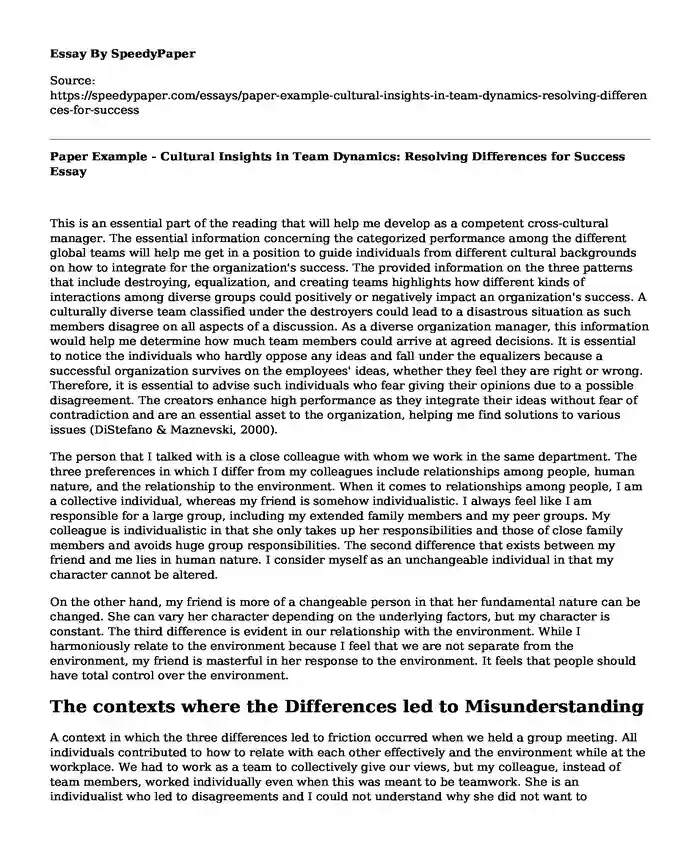
| Type of paper: | Essay |
| Categories: | Management Culture Human |
| Pages: | 4 |
| Wordcount: | 843 words |
This is an essential part of the reading that will help me develop as a competent cross-cultural manager. The essential information concerning the categorized performance among the different global teams will help me get in a position to guide individuals from different cultural backgrounds on how to integrate for the organization's success. The provided information on the three patterns that include destroying, equalization, and creating teams highlights how different kinds of interactions among diverse groups could positively or negatively impact an organization's success. A culturally diverse team classified under the destroyers could lead to a disastrous situation as such members disagree on all aspects of a discussion. As a diverse organization manager, this information would help me determine how much team members could arrive at agreed decisions. It is essential to notice the individuals who hardly oppose any ideas and fall under the equalizers because a successful organization survives on the employees' ideas, whether they feel they are right or wrong. Therefore, it is essential to advise such individuals who fear giving their opinions due to a possible disagreement. The creators enhance high performance as they integrate their ideas without fear of contradiction and are an essential asset to the organization, helping me find solutions to various issues (DiStefano & Maznevski, 2000).
The person that I talked with is a close colleague with whom we work in the same department. The three preferences in which I differ from my colleagues include relationships among people, human nature, and the relationship to the environment. When it comes to relationships among people, I am a collective individual, whereas my friend is somehow individualistic. I always feel like I am responsible for a large group, including my extended family members and my peer groups. My colleague is individualistic in that she only takes up her responsibilities and those of close family members and avoids huge group responsibilities. The second difference that exists between my friend and me lies in human nature. I consider myself as an unchangeable individual in that my character cannot be altered.
On the other hand, my friend is more of a changeable person in that her fundamental nature can be changed. She can vary her character depending on the underlying factors, but my character is constant. The third difference is evident in our relationship with the environment. While I harmoniously relate to the environment because I feel that we are not separate from the environment, my friend is masterful in her response to the environment. It feels that people should have total control over the environment.
The contexts where the Differences led to Misunderstanding
A context in which the three differences led to friction occurred when we held a group meeting. All individuals contributed to how to relate with each other effectively and the environment while at the workplace. We had to work as a team to collectively give our views, but my colleague, instead of team members, worked individually even when this was meant to be teamwork. She is an individualist who led to disagreements and I could not understand why she did not want to contribute to the team effort.
Another instance of friction occurred when I believed that we should act friendly to the environment as we are part of it. Because we are superior to the environment around us and can control the organizational problems by adjusting certain aspects within the organization, my friend colluded with me because she believes that we are superior to the environment and not equal. She was of a different view that organizational problems could not be solved by altering certain factors and identifying the underlying causes of such issues to determine the elements that require change and then advocate for change. This was unlike my idea, whereby I felt that organizational change could be instilled by adjusting elements in the entire system.
A third difference in the same context was related to our human nature and its differences. I was stuck on my opinions and kept urging because I am unchangeable, while my friend could, at times, change her mind to bring down the disagreement. I could not change my perspective about any issue and hold onto my beliefs. At the same time, my friend could shift even her character from being angry with the disagreement about getting in a position to control her emotions. I hardly change my ideas towards what I feel is a valid fact, but my friend is changeable and can shift her opinions.
Solution
The specific strategy that we came up with to prevent future misunderstandings was to work on aligned goals. We acknowledged that we worked in a culturally diverse environment and looked for ways not to dismiss each other's ideas even if we disagreed with them. It does not mean that we should incorporate everything that we disagree with. Still, we can give our opinions on other people's ideas and beliefs to understand that we are all different.
References
DiStefano, J. J., & Maznevski, M. L. (2000). Creating value with diverse teams in global management. Organizational dynamics.
Cite this page
Paper Example - Cultural Insights in Team Dynamics: Resolving Differences for Success. (2024, Jan 20). Retrieved from https://speedypaper.net/essays/paper-example-cultural-insights-in-team-dynamics-resolving-differences-for-success
Request Removal
If you are the original author of this essay and no longer wish to have it published on the SpeedyPaper website, please click below to request its removal:
- Essay Sample Focusing on Task Conflict within a Team
- Essay Example on Cultural Encounters Manifestation in Literary Works
- Free Essay. A Review of Telephone-Administered Behavior-Based Interview Technique
- Essay Sample: External Forces in Play of Our Identities
- Essay Sample on The History of Tennessee State
- Essay on From Haiti to Project Management: A Scholar's Journey and Vision for Housing Solutions
- American Ideology and Social Life Affects Work - Free Essay
Popular categories




